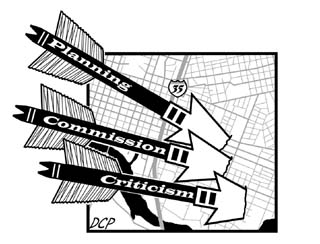Naked City
Planning Lessons
By Mike Clark-Madison, Fri., July 21, 2000

Well, it wasn't as ugly on July 11 as it was on June 28, but the implementation process for the East Cesar Chavez Neighborhood Plan still had another bumpy ride through Planning Commission, which finally gave its blessing to the overlay-and-zoning scheme, with some suggested changes, and sent it on to the City Council.
The battles over the ECC implementation -- pitting two rival East Austin activist coalitions that have waged ad hominem turf wars for decades -- could be seen coming from a mile away. But as the dust settles, what have we, as a city, learned about our vaunted neighborhood planning process after its first real knock-down, drag-out controversy?
Well, a couple of things, according to two of the key city-side players. "There's always going to be some areas of town where a combination of development pressures and local activism will make the program very difficult," says Planning Commissioner Ben Heimsath, who chaired the Citizens Planning Committee effort that spawned neighborhood planning. "But I'm very proud of the way everybody pushed for really bringing forward the issues and [helping the PC] realize that these are issues that have to be dealt with."
Those are kind words from a man who, along with most of his colleagues, sat through hours of "discussion" with El Concilio supporters threatening physical violence and riot, playing a whole casino's worth of race cards, and generally using the three-years-in-the-making ECC plan for target practice. "When fighters have been, for good reason, in fighting mode for so long, it's going to be harder to accommodate them in a visioning process and ... finding solutions that are better than the old fighting mode," Heimsath says.
But the East Cesar Chavez imbroglio highlights an inevitable hazard, or at least a quirk, of neighborhood planning: Even though neighborhood plans are supposed to be apolitical (or at least less political than the traditional land-use battles), involving all stakeholders across the board, and ratified as the will of the neighbors by popular vote, they still have to, at the end of the day (or year, or three years) go before the Planning Commission and council to be approved, and then again to be implemented with re-zonings, overlays, and other land-use changes.
Which means that they end up like the contentious zoning cases to which they were supposed to be an alternative, where any citizen with a grudge has a chance to sway PC and council opinions. The El Concilio leaders determined to shoot down the ECC plan probably could have succeeded if they'd been a little more assiduous about linking their anger to specific land-use issues that the PC could address, instead of asking the city, in a not-so-friendly way, to in effect stop white people from moving to the Eastside.
But there's no way that we can bind the PC and council to approving whatever the neighborhood, through its planning process, says it wants, and closing the door on lively, if fractious and specious, discourse. "There's no getting around the fact that this is a political process," says Heimsath. But by giving the neighborhoods the opportunity to resolve its issues beforehand, and differently than before, "we proved -- especially with East Cesar Chavez, which a lot of people three years ago thought would never see the light of day -- that people looking with cool heads at their neighborhood issues can produce a sound response. I think neighborhood planning proved itself last Tuesday night." He adds that the Chestnut neighborhood, "with barely a blink," secured PC approval for its implementation.
So is there no better way? "There are debates we can get through only by putting our heads down and slogging through the storm," says neighborhood planning manager Carol Barrett. "Because it's new. This was a pilot neighborhood plan, and we're piloting the implementation process for the plan, and we have to expect that it'll be bumpy." Barrett adds that city staff probably bit off more than they could chew by springing both the specific proposals for East Cesar Chavez, and the new (and complex) zoning classifications and processes developed to implement neighborhood plans, on the PC and the community at the same time.
Because it's new, "there's no reason for people to respect the process and the work," Barrett continues. "The council has to say, 'we respect the process and the work,' and the first few times they do that, the issues will resolve themselves. People will go to the planning table because they realize that council will," when a contentious issue arises, "presume the weight goes to the adopted neighborhood plan."
Got something to say on the subject? Send a letter to the editor.








